From thriving to surviving and back again
For most of my life I’ve enjoyed the challenge of setting goals and making them happen. I’ve learned that the actions I choose can take me from surviving to thriving. I love to have a go at something new, especially adventurous activities. For a few years this seemed to slow down a bit. Perhaps it was my added commitment to my young family, our relocation to a rural area, or maybe even a simple ‘rut’ I got myself into. When life was more about surviving the usual (and not so usual) childhood illnesses, school assignments, getting the bills paid, and retrenchments, I often felt a long way from thriving.
Maybe it was my approaching middle age that brought along a renewed urge to live life as fully as possible. I know that I function at my best when I have a goal to aim for, and so when I began to focus on this aspect of myself again, I rediscovered my passion for adventure. Here I will share with you the actions that took me from surviving to thriving – you can do it too!
Goal-setting and problem-solving are key skills to success
The skills of setting goals and creatively problem-solving are key factors to success. Success doesn’t just happen. You have to create it, to action it, and to problem-solve it. It doesn’t always come easily, and we often shy away from the actions we need to take. We secretly keep our inner dreams to ourselves out of fear of failure.
Get your goal out there!
 I’m sharing with you one of my goals that I’ve had floating about in my head for a long time. Putting it out there in the public arena is definitely not easy. I have a lot of doubts about whether I’ll succeed, but if I keep suppressing my dream, there won’t be any chance of success.
I’m sharing with you one of my goals that I’ve had floating about in my head for a long time. Putting it out there in the public arena is definitely not easy. I have a lot of doubts about whether I’ll succeed, but if I keep suppressing my dream, there won’t be any chance of success.
Getting clear on my goal
I’m using the post 9 Steps to Achieving Your Dreams and Goals to help me get clear on just what it is I want to achieve, and why. This clarity will give me direction and motivation.
STEP 1 – IDENTIFY AN AREA FOR CHANGE
I want my life to be filled with adventurous activities instead of ho-hum routine.
STEP 2 – STAY FOCUSED ON THE CHANGE, DON’T BE DISTRACTED BY PROBLEMATIC THOUGHTS
There are plenty of problems associated with spending more time in adventurous activities. But when I’ve overcome them I’ll be living the life I want – full of activity, travel, inspiration, energy, feeling great! I’ll focus my attention on how I want it to be instead of what the problems are.
STEP 3 – SELECT YOUR SMART GOAL
I WILL GO ON AN OVERNIGHT HIKE – something I haven’t done before!
Is it measurable? Yes
Is it achievable? Yes, I’m comfortable and competent with bushwalking and camping, so the new challenge combines this with carrying my supplies.
Is it realistic? Yes, I’m reasonably fit, healthy, strong, sensible and organised. I’ll research and access resources and networks, borrow or buy equipment that I need.
Does it have a timeframe? I’ll avoid extreme weather conditions and give myself enough lead-in time to gather and test out equipment, do my research, and train to carry the weight of my pack. Spring will be an ideal season and I can select a date closer to the time based on weather and what suits my fellow hiker/s.
STEP 4 – WRITE IT DOWN!
Yep – here it is! In the public arena too! (Talk about pressure now!) But you don’t have to go public with your goal. There’s power in simply writing it down for your own reference.
STEP 5 – KNOW YOUR WHY! COMMITMENT NOT MOTIVATION!
I want to challenge the fears that limit me. I want to connect more closely with nature and discover my part in the world, learn to trust myself and stretch my limits, tap into my inner strength, develop self-reliance, and I want to finally use the backpack I bought years ago! When I feel unmotivated, I can look back at my “why” and stay committed to my goal.
STEP 6 – BREAK IT DOWN into steps
- Research places, people, information, equipment
- Talk to others who might like to share the adventure with me
- Identify and collect equipment
- Trial various hiking foods and equipment
- Go on training hikes with increasing distance and weight in back pack
- Select a date (and a couple of back-up dates in case of adverse weather, sickness etc) and book campsites if necessary
STEP 7 – STEP INTO YOUR GOAL
I’ll take each step one at a time and gradually work my way towards an overnight hike.
STEP 8 – CREATIVELY PROBLEM-SOLVE ISSUES THAT ARISE
There are some predictable problems, and other new ones might arise. But I won’t give up – I’ll use the Creative Problem-solving Train (keep reading).
STEP 9 – REWARD YOURSELF!
External rewards can be a blast, but that feeling of success I’ll have when I’ve achieved this goal – yeah, that – that’ll be my reward 🙂
6 steps to smash my goal using ‘The Problem-solving Train’
Before I even get started, I’m thinking of all the ways that I could fail! So here I’m using the Problem-solving Train to anticipate and manage the obstacles.
STEP 1 – Probable, possible and unlikely problems
 Probable problems: no toilets or showers, snakes, sore back and shoulders
Probable problems: no toilets or showers, snakes, sore back and shoulders
Possible problems: hot weather, cold weather, rain, leeches, bush ticks, insufficient drinking water, equipment too heavy or too expensive, no child care, fire danger
Unlikely problems: I might be miserable, difficulty finding a suitable hiking buddy, sickness
STEP 2- choose one probable problem and brainstorm solutions
Probable problem #1: No toilets or showers
Brainstormed solutions: Hike near, and camp overnight at a site with facilities, read about and listen to podcasts about bush toilet hygiene, read stories of overnight hikers, hold on and avoid toileting as much as possible, take a porta-loo, find out about toileting aids for bushwalkers, have a wash down or swim instead of a shower, avoid extremely hot weather, talk to experienced hikers about bush hygiene, remind myself that if others can do it so can I, think about how clean I’ll feel when I get to shower afterwards – WOW! There sure is a lot of possibilities here!
STEP 3 – pros and cons
Most of my brainstormed solutions are quite useful and viable, although I don’t think I’ll take a porta-loo (too heavy, smelly, awkward, embarrassing) and I don’t think it’s a good idea to avoid toileting (hmmm, that could be uncomfortable and bring on health problems).
STEP 4 – THE BEST OPTION/S
I think it’s best to deal with this problem from multiple angles so I’m going to include several action-based and mind-based strategies in my Plan of Action to deal with this problem.
STEP 5 – PLAN OF ACTION
 Choose a route and campsite for my first overnight hike that has facilities
Choose a route and campsite for my first overnight hike that has facilities
Read about and listen to podcasts about bush toilet hygiene – this could come in handy someday even if I don’t need it this time!
Talk to experienced hikers about my plans including managing bush hygiene
Read stories written by overnight hikers
Find out about lightweight toileting aids for bushwalkers
Remind myself that if others can do it, so can I!
STEP 6 – REVIEW
Once I’ve actioned my plan I can review it, even before I go on my first overnight hike. Am I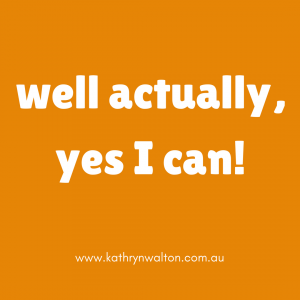 feeling more comfortable about the issue of toileting and showering on my overnight hike? Are there any new problems I need to address? I can go back to my other brainstormed solutions, or come up with new ones. I can flex my plans to help me achieve my goal instead of simply giving up. I can push through the discomfort of the plan not working out perfectly, and tap into my determined attitude to succeed.
feeling more comfortable about the issue of toileting and showering on my overnight hike? Are there any new problems I need to address? I can go back to my other brainstormed solutions, or come up with new ones. I can flex my plans to help me achieve my goal instead of simply giving up. I can push through the discomfort of the plan not working out perfectly, and tap into my determined attitude to succeed.
Keep on solving!
Once I’ve got my plans in place for all the probable and possible problems I’ve identified, it’s full steam ahead. I’m already most of the way there! It’s in this phase of identifying and then creatively solving the problems that most people get stuck. It’s this process that makes the difference on the road to success. And for me personally, it’s an exciting ride moving from surviving to thriving, making my goal of living an adventurous life a reality instead of leaving it as a whimsical dream. Stay tuned for future updates as I smash this goal!
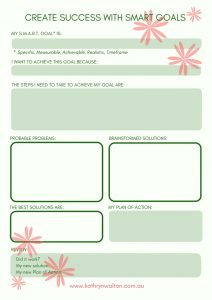 FREE GIFT! To help you clarify and action YOUR goal (whether it’s big or small or anywhere in between), download your FREE printable Create Success With SMART Goals. This handy worksheet will step you through a simplified process to identify your S.M.A.R.T. goal, your “why”, the steps you need to take to achieve your goal, any problems that might get in the way of success, and creative solutions that will propel you towards success.
FREE GIFT! To help you clarify and action YOUR goal (whether it’s big or small or anywhere in between), download your FREE printable Create Success With SMART Goals. This handy worksheet will step you through a simplified process to identify your S.M.A.R.T. goal, your “why”, the steps you need to take to achieve your goal, any problems that might get in the way of success, and creative solutions that will propel you towards success.
Click here to download your FREE printable “Create Success With SMART Goals” from the RESOURCES tab on my website, and check out the other printables and resources while you’re there!
Discovering mountain biking as life’s ultimate parallel universe in her middle age,  Kathryn Walton shares information and reflections in Daisy Spoke that connect, inspire and self-empower women to make healthy choices for themselves. She integrates her love of physical exercise, family, nature, gardening and creative arts with her professional background in mental health social work to facilitate change with individuals, groups and communities of women who are committed to living life to the full.
Kathryn Walton shares information and reflections in Daisy Spoke that connect, inspire and self-empower women to make healthy choices for themselves. She integrates her love of physical exercise, family, nature, gardening and creative arts with her professional background in mental health social work to facilitate change with individuals, groups and communities of women who are committed to living life to the full.


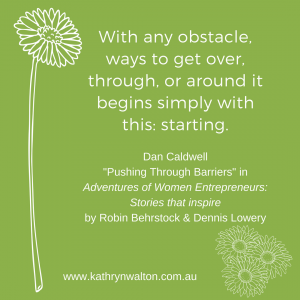
 time I respect them. I teach many individuals and groups how to use goals to enhance their mental health and wellness, and I see amazing progress when they are used effectively.
time I respect them. I teach many individuals and groups how to use goals to enhance their mental health and wellness, and I see amazing progress when they are used effectively. 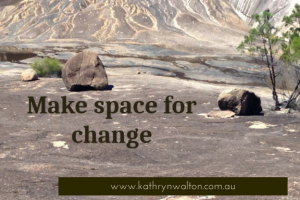
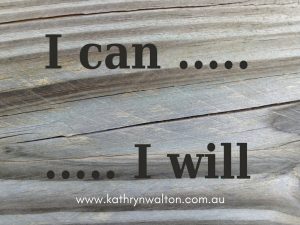 Remember all those problems your mind started to thinking about in Step 2? Problem-solving is where the power is (another blog later this month will look at this in more detail). Persistence makes all the difference between giving up on your goal (and yourself) and being unstoppable. Some of the problems will be predictable and you’ll be able to plan for them. Others less so.
Remember all those problems your mind started to thinking about in Step 2? Problem-solving is where the power is (another blog later this month will look at this in more detail). Persistence makes all the difference between giving up on your goal (and yourself) and being unstoppable. Some of the problems will be predictable and you’ll be able to plan for them. Others less so. In the meantime, if you haven’t already signed up for Grounded Inspiration, now’s a great time to do that. Never miss out on the latest news, inspiration or blog posts! And be the first to hear about my new releases throughout the year as I develop and publish programs to enhance women’s wellness and professional knowledge.
In the meantime, if you haven’t already signed up for Grounded Inspiration, now’s a great time to do that. Never miss out on the latest news, inspiration or blog posts! And be the first to hear about my new releases throughout the year as I develop and publish programs to enhance women’s wellness and professional knowledge.